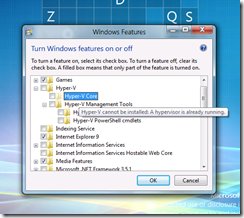 It has been revealed in a recent leaked build of Windows 8, that the operating system Microsoft currently code names Windows 8, contains Hyper-V 3.0 technology and a new virtual hard drive format called VHDX.
It has been revealed in a recent leaked build of Windows 8, that the operating system Microsoft currently code names Windows 8, contains Hyper-V 3.0 technology and a new virtual hard drive format called VHDX.
It has been assumed by several sites that the features have been a part of Windows 8 for quite some time, however due to the lack of 64-bit builds and more focus being placed on mainstream consumer features, they were yet to be picked up by enthusiasts.
Link – http://www.neowin.net/news/hyper-v-30-coming-to-windows-8
 Microsoft Hyper-V Server 2008 R2 is a stand-alone product that provides a reliable and optimized virtualization solution enabling organizations to improve server utilization and reduce costs. With the addition of new features such as live migration and expanded processor and memory support for host systems, it allows organizations to consolidate workloads onto a single physical server and is a good solution for organizations who are consolidating servers as well as for development and test environments.
Microsoft Hyper-V Server 2008 R2 is a stand-alone product that provides a reliable and optimized virtualization solution enabling organizations to improve server utilization and reduce costs. With the addition of new features such as live migration and expanded processor and memory support for host systems, it allows organizations to consolidate workloads onto a single physical server and is a good solution for organizations who are consolidating servers as well as for development and test environments.